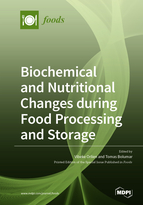Biochemical and Nutritional Changes during Food Processing and Storage
A special issue of Foods (ISSN 2304-8158). This special issue belongs to the section "Food Physics and (Bio)Chemistry".
Deadline for manuscript submissions: closed (31 May 2019) | Viewed by 43042
Special Issue Editors
Interests: non-thermal technologies; food processing; protein modification; protein functionality; food product development; food chemistry
Special Issues, Collections and Topics in MDPI journals
Interests: meat biochemistry and quality; meat processing and packaging; non-thermal food processing methods; emerging meat processing methods; high pressure processing (HPP); shockwave; pulsed electric fields(PEF); plant-based meats
Special Issue Information
Dear Colleagues,
Food processing by humans goes a long way back in time, e.g., heat for cooking was used 1.9 million years ago. However, now, meal preparation seems to be moving out of the home kitchen and pre-processed or processed/convenience food products are becoming a larger part of daily diet. In addition, consumers are progressively focusing on the impact of their food on health, and demand foods that have a high nutritional quality, aroma and natural flavor, similar to freshly-made products. Therefore, nutritional quality is concurrent with food safety, and sensory perception is becoming an increasingly-important factor in food choices. The human digestive tract disintegrates food in order for the nutrients to be released and be made available to the body. However, nutrients can undergo unwanted degradation upon processing and subsequent storage, negatively influencing the physiological effects. Different processing techniques will result in different food structures, thereby also affecting bioaccessibility and nutritional value. Hence, food scientists and industry have an increased interest in both conventional and innovative processing methods, which can provide products of good quality and of high nutritional value, along with a stable shelf life.
This Special Issue aims to shed some light on the latest knowledge about and developments within the effect of food processing and storage on changes of biochemical and nutritional compounds. Both, original research articles and reviews are welcome.
Prof. Vibeke Orlien
Guest Editor
Manuscript Submission Information
Manuscripts should be submitted online at www.mdpi.com by registering and logging in to this website. Once you are registered, click here to go to the submission form. Manuscripts can be submitted until the deadline. All submissions that pass pre-check are peer-reviewed. Accepted papers will be published continuously in the journal (as soon as accepted) and will be listed together on the special issue website. Research articles, review articles as well as short communications are invited. For planned papers, a title and short abstract (about 100 words) can be sent to the Editorial Office for announcement on this website.
Submitted manuscripts should not have been published previously, nor be under consideration for publication elsewhere (except conference proceedings papers). All manuscripts are thoroughly refereed through a single-blind peer-review process. A guide for authors and other relevant information for submission of manuscripts is available on the Instructions for Authors page. Foods is an international peer-reviewed open access semimonthly journal published by MDPI.
Please visit the Instructions for Authors page before submitting a manuscript. The Article Processing Charge (APC) for publication in this open access journal is 2900 CHF (Swiss Francs). Submitted papers should be well formatted and use good English. Authors may use MDPI's English editing service prior to publication or during author revisions.
Keywords
- Food processing
- Process technology
- Biochemical and nutritional changes
- Food structure and nutritional properties
- Food component bioaccessibility








